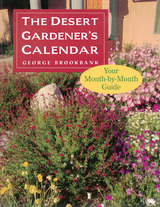
Whether you're raising vegetables, nursing citrus trees, or just trying to keep your front yard looking its best, you'll find that this handy book gives you a valuable month-by-month perspective on the year. It helps you to focus on necessary activities and reminds you of simple tasks you might overlook.It's especially valuable for people who've moved to the desert regions from other parts of the country and follow old gardening dates that seldom apply to their new home.
The Desert Gardener's Calendar is a guide to the maintenance you need to do to keep your garden flourishing and your landscape attractive throughout the year. It combines the month-by-month gardening and landscaping activities from two separate books by George Brookbank—Desert Gardening, Fruits and Vegetables and Desert Landscaping—and was created in response to readers who have found the calendar sections of those books especially invaluable.
And because not all deserts are the same, Brookbank is careful to point out differences in scheduling encountered by gardeners in low- and middle-elevation regions in California and the Southwest. "I believe," says the author, "that if you use this calendar and let your judgment become more accurate with experience, you'll soon be doing everything right." Although that might suggest a day when you don't need this book, chances are good that, if you're a desert gardener, right now you do.
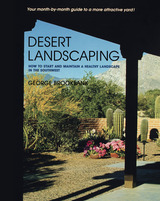
CONTENTS
Part 1 - How to Start and Maintain a Desert Landscape
1. Desert Conditions: How They Are "Different"
2. Plants Are Like People: They're Not Alike
3. Use Arid-Land Plants to Save Water
4. How to Irrigate in the Desert
5. How to Design and Install a Drip Irrigation System
6. Soils and Their Improvement I: How to Plant in the Desert
7. Soils and Their Improvement II: How to Use Fertilizers
8. What to Do When Things Go Wrong: A Troubleshooter's Guide
9. How to Avoid—and Repair—Frost Damage
10. How to Control "Weeds"
11. Palo Verde Borer Beetle: What to Do
12. How to Avoid Texas Root Rot
13. When You Move Into an Empty House
14. What to Do About Roots in Drains
15. How to Dig Up Plants and Move Them
16. How to Have Flower Bed Color All Year
17. Landscape Gardening with Containers
18. Starting Wildflowers
19. Starting a Lawn
20. Making and Keeping a Good Hedge
21. Pruning Trees and Shrubs
22. Palm Tree Care
23. Caring for Saguaros, Ocotillos, Avages, and Prickly Pears
24. Roses in the Desert: Hard Work and Some Disappointments
25. Landscaping with Citrus
26. Swimming Pools: Plants, Play, and Water-Saving
27. Landscape Maintenance While You're Away
28. Condominiums: Common Grounds, Common Problems
Part 2 - A Month-by-Month Maintenance Guide
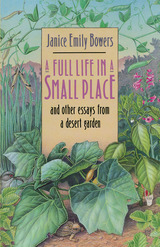
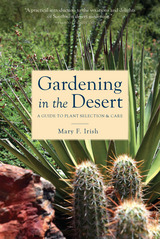
Newcomers to the Southwest usually find that their favorite landscape plants aren't suited to the hot, dry climate. Many authors offer advice on adapting plants to the desert; now Mary Irish tells how gardeners can better adapt themselves to the challenge.
Drawing on her experience with public horticulture in the Phoenix metropolitan area, Irish explores the vexations and delights of desert gardening. She offers practical advice on plants and gardening practices for anyone who lives in the Southwest, from El Paso to Palm Springs, Tucson to Las Vegas.
Irish encourages readers who may be new to the desert—or desert dwellers who may be new to gardening—to stop struggling against heat, aridity, and poor soils and instead learn to use and appreciate the wonderful and well-adapted plants native to the desert. She shares information and anecdotes about trees, shrubs, perennials, agaves, cacti, and other plants that make gardening in the Southwest a unique experience, and provides further information about plants from other desert regions that will easily adapt to the Southwest. In addition to descriptions of plants, Irish also offers tips on planting, watering, pruning, and propagation.
For anyone who has struggled to maintain a patch of green or blanched at their water bill after unproductive irrigation, the answer to an attractive landscape may be as close as the desert around you. And for anyone who has bought a catalog guide to desert plants and not known which to choose, this book can set you on the right path. Mary Irish shows how to take heart in available plants of adaptable beauty in a book to enjoy while waiting for the next planting cycle.
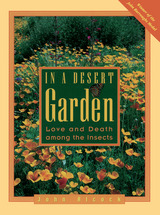
As Alcock studies the plants in his yard, he shares thoughts on planting, weeding, and pruning that any gardener will appreciate. And when commenting on the mating rituals of spiders and beetles or marveling at the camouflage of grasshoppers and caterpillars, he uses humor and insight to detail the lives of the insects that live in his patch of desert. Celebrating the virtues of even aphids and mosquitoes, Alcock draws the reader into the intricacies of desert life to reveal the complex interactions found in this unique ecosystem. In a Desert Garden combines meticulous science with contemplations of nature and reminds us that a world of wonder lies just outside our own doors.
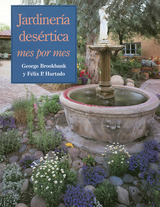
Jardinería desértica---mes por mes le servirá de guía para cuidar las plantas de su jardín y determinar el mejor tiempo para plantar, podar, y regar. Este libro es especialmente útil para los jardineros y residentes recién llegados al sudoeste desértico. Si usted cultiva vegetales o árboles frutales y cítricos, o si sencillamente quiere mantener un jardín hermoso, encontrará que este libro práctico le informará sobre las labores necesarias y le ayudará a recordar las tareas importantes que inadvertidamente podría olvidar.
Now available in a Spanish-language edition, this popular guide provides pointers to the maintenance needed to keep gardens flourishing and landscapes attractive throughout the year. Translated by master gardener Félix Hurtado, Jardinería desértica makes a wealth of common-sense wisdom available to Spanish-speaking readers.
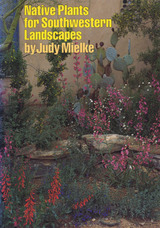
Winner, Xeriscape Award of Recognition, Arizona Municipal Water Users Association
Southwest Book Award, Border Regional Library Association
For gardeners who want to conserve water, the color, fragrance, shade, and lush vegetation of a traditional garden may seem like a mirage in the desert. But such gardens can flourish when native plants grow in them. In this book, Judy Mielke, an expert on Southwestern gardening, offers the most comprehensive guide available to landscaping with native plants. Writing simply enough for beginning gardeners, while also providing ample information for landscape professionals, she presents over three hundred trees, shrubs, vines, grasses, groundcovers, wildflowers, cacti, and other native plants suited to arid landscapes.
The heart of the book lies in the complete descriptions and beautiful color photographs of plants native to the Mojave, Sonoran, and Chihuahuan desert regions of the southwestern United States and northern Mexico. Mielke characterizes each plant and gives detailed information on its natural habitat, its water, soil, light, temperature, and pruning requirements, and its possible uses in landscape design.
In addition, Mielke includes informative discussions of desert ecology, growing instructions for native plants and wildflowers, and "how-to" ideas for revegetation of disturbed desert areas using native plants. She concludes the book with an extensive list of plants by type, including those that have specific features such as shade or fragrance. She also supplies a list of public gardens that showcase native plants.
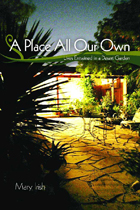
For twenty years Mary Irish, along with her husband Gary, tended a garden in Scottsdale, Arizona. Over the years they transformed it into a lively and lovely spot that reflected both its place in the world—hot, dry, and often hostile to gardeners who don’t understand its ways—and the particular passions of its two creators. Of course, not everything went as planned, and the garden talked back as much as it obeyed. But for these two gardeners, the unexpected outcome is one of gardening’s great pleasures.
Mary Irish is a delightful writer. With grace, wit, and obvious affection, she tells the story of how she and Gary transformed a barren half-acre plot around their house in the center of Greater Phoenix into a haven: for its creators and their friends, for the birds and insects and other critters that have discovered it, and for the plants that have made it their home. Although it describes the experience of gardening in one of the most extreme climates in the inhabited world, A Place All Our Own will interest anyone who gardens—and everyone who enjoys a well-told, true-life nature tale.
READERS
Browse our collection.
PUBLISHERS
See BiblioVault's publisher services.
STUDENT SERVICES
Files for college accessibility offices.
UChicago Accessibility Resources
home | accessibility | search | about | contact us
BiblioVault ® 2001 - 2024
The University of Chicago Press









